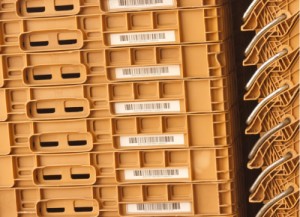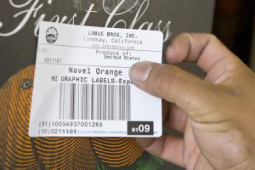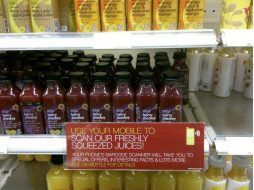How the food industry can take advantage of bar code and radio frequency identification (RFID) technologies to improve safety, reduce operating expenses, meet compliance requirements, and improve efficiency
by Zebra Technologies
 In the early days of bar coding, an Efficient Foodservice Response (EFR) study identified $847 million in savings potentially available by expanding bar coding within the food supply chain. Since then, the U.S. Bioterrorism Act, European Union Food Law, and Hazard Analysis and Critical Control Points (HACCP) requirements mandate improved product identification and traceability. Today, technologies, techniques, and standards exist to help organizations throughout the food supply chain gain complete traceability for safety, compliance, and business process improvement.
In the early days of bar coding, an Efficient Foodservice Response (EFR) study identified $847 million in savings potentially available by expanding bar coding within the food supply chain. Since then, the U.S. Bioterrorism Act, European Union Food Law, and Hazard Analysis and Critical Control Points (HACCP) requirements mandate improved product identification and traceability. Today, technologies, techniques, and standards exist to help organizations throughout the food supply chain gain complete traceability for safety, compliance, and business process improvement.
Momentum is growing to implement whole-chain traceability, which includes internal and external visibility, from the grower, through the distributor, to the retailer. A key industry effort is the Produce Traceability Initiative (PTI), which strives to achieve supply chain-wide adoption of electronic traceability of every case of produce. Once fully adopted, PTI will improve the effectiveness of current trace-back procedures while enabling common standards for future traceability systems.
Consumer confidence
Food manufacturers and distributors are looking at supply chain visibility technologies to improve food safety and consumer confidence. The April 2010 salmonella outbreak resulted in over 1,000 people becoming sick, the recall of over 550 million eggs, and a tarnished image of the poultry industry. This scenario is a prime example of where RFID and bar codes coupled with supply chain collaboration can provide timely, actionable data related to the movement of goods throughout the supply chain and traceability for regulatory compliance. In fact, the burden of compliance and food safety prevention often depends on active efforts within the food industry.
Unfortunately, traceability in the U.S. food supply chain is moving at a slow pace. Lack of compliance places more burden on an already stretched FDA to track down the origins of food borne illnesses. Moving RFID and bar code labeling and scanning deeper in food grower, shipping and packaging chains enables easier tracing throughout the product lifecycle.
Full food supply chain visibility provides an extra layer of protection when a food borne illness occurs, such as the salmonella outbreak mentioned earlier. Visibility allows growers and distributors to determine if the contamination occurred at the grower, or was introduced within the distribution process, and who might else be affected.
 Consider the following case example. A Zebra Technologies customer in the baking industry reduced its inventory and distribution costs by $3 million in the first year after installing an automated pallet labeling and identification system. The company, which operates six warehouses throughout the U.S. and previously was not able to measure and balance inventory throughout its operations, began printing and applying bar code labels to all its cases and pallets and then scanning the bar codes to capture quantity, location and product identification numbers, including lot codes.
Consider the following case example. A Zebra Technologies customer in the baking industry reduced its inventory and distribution costs by $3 million in the first year after installing an automated pallet labeling and identification system. The company, which operates six warehouses throughout the U.S. and previously was not able to measure and balance inventory throughout its operations, began printing and applying bar code labels to all its cases and pallets and then scanning the bar codes to capture quantity, location and product identification numbers, including lot codes.
The system enabled the company to gain an accurate, timely view of inventory and to increase the average number of pallets per shipment from 47 to 61, a 30 percent improvement. By increasing load yields, the company significantly reduced the need for expensive less-than-truckload (LTL) shipments to customers to fulfill orders, which contributed greatly to cost savings.
Shortly after implementing the system, the company recalled some products because it received a bad batch of ingredients from a supplier. Using the lot number information captured from bar code scanning, the company traced its shipments and conducted a highly targeted recall by contacting only those customers who had received the affected products. The recall completed quickly, with minimized cost, and without having to pull unaffected products from store shelves.
 The bar code traceability system described above is typical, and relies on standard, commonly used linear bar code formats for cases and pallets. Increased traceability and other applications are possible using more advanced, standardized identification technologies such as GS1 DataBar (RSS) bar codes and RFID. RSS targets produce, loose items, and other difficult to identify products. There are high data capacity versions of RSS that enable encoding of lot codes or other traceability information.
The bar code traceability system described above is typical, and relies on standard, commonly used linear bar code formats for cases and pallets. Increased traceability and other applications are possible using more advanced, standardized identification technologies such as GS1 DataBar (RSS) bar codes and RFID. RSS targets produce, loose items, and other difficult to identify products. There are high data capacity versions of RSS that enable encoding of lot codes or other traceability information.
The EPC RFID system creates a unique serial number for each item (in contrast to a U.P.C./EAN number that identifies the product type and manufacturer), which is very helpful for traceability applications. Rewritable RFID tags that have extra memory sufficient for lot codes and other information support EPC. Encoders can update RFID tags with time stamps and transaction records to create electronic pedigrees. Smart tags (battery-powered RFID) can record temperatures and other environmental data critical for the fresh produce industry.
Improving identification
Traceability technologies provide efficient, accurate ways to comply with regulations such as the Bioterrorism Act and the EU Food Law, which require businesses to collect, process, and store vast amounts of information. Recent legislation in the U.S. includes the Food Safety Enhancement Act of 2009 (H.R. 2749), which seeks to improve the safety of food from both domestic and international sources. PTI uses a Global Trade Item Number (GTIN) to achieve traceability. The GTIN includes a GS1 company prefix and a unique item reference number compatible with UPC bar codes, and RFID or human readable codes.
Automated data collection removes much of the time and expenses required for data processing, while building a foundation for other efficient business processes. Data collection by bar code and RFID is exceptionally accurate (accuracy often tops 99 percent), which can help prevent errors in order picking and shipping that plague the food industry.
 Bar code scanning records product codes, lot numbers, invoice data, order numbers, and other information in less than a second. Gathering this information manually is time consuming, because workers must first record the information at the point of activity, then transcribe and enter the data into the computer system. The redundant manual data recording procedures provide two opportunities to record the information incorrectly. Errors occur in 36 percent of consumer-packaged goods orders according to a study by the Grocery Manufacturers Association (GMA). Such errors lead to inventory inaccuracy and eventually to out-of-stocks—acknowledged as a multi-billion dollar problem.
Bar code scanning records product codes, lot numbers, invoice data, order numbers, and other information in less than a second. Gathering this information manually is time consuming, because workers must first record the information at the point of activity, then transcribe and enter the data into the computer system. The redundant manual data recording procedures provide two opportunities to record the information incorrectly. Errors occur in 36 percent of consumer-packaged goods orders according to a study by the Grocery Manufacturers Association (GMA). Such errors lead to inventory inaccuracy and eventually to out-of-stocks—acknowledged as a multi-billion dollar problem.
Errors
Consider the effect of a common shipping error in which an employee picks the wrong SKU to fulfill a customer order. The customer might discover the error while validating the shipment at receiving, and would engage the delivery driver to help resolve it. If someone discovered the error later, it would result in a call to the supplier’s sales or customer service department. In either case, the distributor incurs labor charges to research and correct the mistake.
Involving the driver at the time of delivery creates delays that would cause the driver to miss delivery windows with other customers, causing additional problems and possibly creating the need for an additional, rush shipment from the distribution center. The customer will hold up payment of the invoice until the error is resolved, slowing the cash cycle. These actions, which all trace back to a preventable warehouse picking error, can have a significant impact on productivity and profitability if they become an accepted part of doing business.
